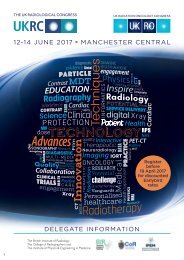Towards Safer Radiotherapy
Towards Safer Radiotherapy
Towards Safer Radiotherapy
You also want an ePaper? Increase the reach of your titles
YUMPU automatically turns print PDFs into web optimized ePapers that Google loves.
• The multidisciplinary team of professionals involved in radiotherapy has a common goal<br />
including the avoidance of errors and untoward incidents. Vincent 20 has pointed out that<br />
teams can erode or create safety. Erosion is a consequence of members of the team<br />
working alone, perhaps assuming the roles and functions of others. In contrast, creation,<br />
or at least improvement, of safety follows from continual effective communication in a<br />
climate of supportive interprofessional reinforcement.<br />
• Communication in this environment has to find the delicate balance between respect for<br />
specific knowledge, skills and status and the right of each member of the team and<br />
patients to challenge statements and assumptions which bear on the safe outcome of<br />
the process.<br />
26<br />
Recommendation<br />
Each radiotherapy centre should hold regular multidisciplinary management meetings. In<br />
addition, there should be regular multidisciplinary meetings to discuss operational issues,<br />
including the introduction of new technologies and practices. These meetings should be<br />
informal to encourage interprofessional challenge, while respecting professional boundaries<br />
and qualifications.<br />
4.2.7 While the multidisciplinary team has a role in the general management of each centre, it is<br />
also necessary to recognise that specific multidisciplinary teams will need to be formed for<br />
more specific tasks.<br />
Examples include:<br />
• Individual patient reviews of complex cases<br />
• Technique development, such as introduction of intensity modulated radiotherapy<br />
(IMRT) for a particular tumour site<br />
• Equipment procurement.<br />
While multidisciplinary communication is important, one must also recognise that<br />
communication within each professional group is equally important. In this environment,<br />
there are particular dangers that can arise from hierarchy where those at lower levels can be<br />
reluctant to challenge their senior colleagues who are likely to have been involved in their<br />
training and are equally likely to be involved in their future career progression.<br />
4.2.8 The ability of staff to talk to their colleagues and superiors about safety incidents is an<br />
important feature of creating a culture which is open and fair, and which is non-punitive.<br />
This does not mean that staff are not accountable for their actions but rather organisations<br />
need to demonstrate the right balance between both accountability and openness. 59<br />
Deference is little defence against the adverse effects of errors and untoward incidents.<br />
4.2.9 Based on a model developed by Professor James Reason, the National Patient Safety Agency<br />
(NPSA) has created the Incident Decision Tree (IDT) to help organisations take a systematic,<br />
transparent and fair approach to decision-making with staff who have been involved in a<br />
safety incident (Appendix 4.2). 59 More information on the use of the IDT is available on the<br />
NPSA website: www.npsa.nhs.uk<br />
<strong>Towards</strong> <strong>Safer</strong> <strong>Radiotherapy</strong>



